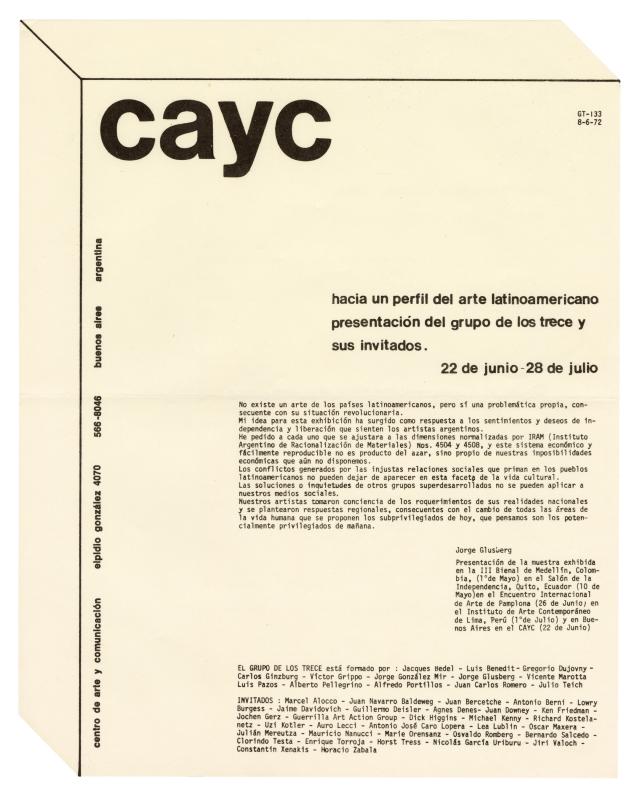Ever since it was founded, the CAYC (Centro de Arte y Comunicación), helmed by the cultural promoter, artist, and businessman Jorge Glusberg, was intended as an interdisciplinary space where an experimental art movement could flourish. The establishment of collaborative networks connecting local and international artists and critics played an important role in this process. The exhibitions shone a light on these exchanges, in which overviews of trends or individual artists provided an introduction to the innovations of international contemporary art and made Argentine and Latin American artists better known on the global scene.
At the III Bienal de Arte Coltejer (Medellín, May 1972), the CAYC presented three exhibitions: Arte de Sistemas, Arte de Sistemas en Argentina, and Hacia un perfil del arte latinoamericano. Though the first of these was a repeat of the one that was staged in 1971 (including international artists), Glusberg’s essay in the catalogue for the Colombian biennial notes that “arte de sistemas” took on a different, more flexible connotation that became associated with a possible regional Latin American identity. As a reflection of the decade when the countries in the Southern Cone were all under the fascist thumb of military dictatorships, the emphasis on the political “profile” was timely. Spreading the term—throughout the 1970s as it evolved from a process of assimilation to one of distinction—was the CAYC’s strategy for raising its international profile.
It was subsequently shown at the Salón de la Independencia (Quito, Ecuador, May 1972); in Buenos Aires (June 1972); at the Encuentro Internacional de Arte in Pamplona (June 1972); at the Amadis gallery in Madrid (February 1973); at the Dudley Peter Allen Memorial Art in Ohio (March 1974); at the Hochschule für Bildende Künste (Advanced School of Visual Arts) in Hamburg (July 1974); and at the Agora Studio (Maastricht, Holland, in October 1974).
Hacia un perfil… showed works in which Argentinean and international artists pondered the political situation that was common to all their countries. The exhibition provided a perspective on art and the Grupo de los Trece’s ideology in a concise overview of contemporary regional art. “Arte de sistemas”not only referred to international process art; its political stance, absorbed over the course of its many productions and presentations, gave it an identity of its own and associated it with the region. In his introduction to the exhibition, Glusberg said: “There is no Latin American art as such, but the region’s individual countries do share a common problem in terms of their revolutionary situation.” (GT-133 [doc. no. 1476312].)
The heliographic technique and the ability to make copies at low cost led to increased circulation and the option to exhibit images in several places at the same time. Guest artists, Argentinean and foreign, varied from one venue to another.

